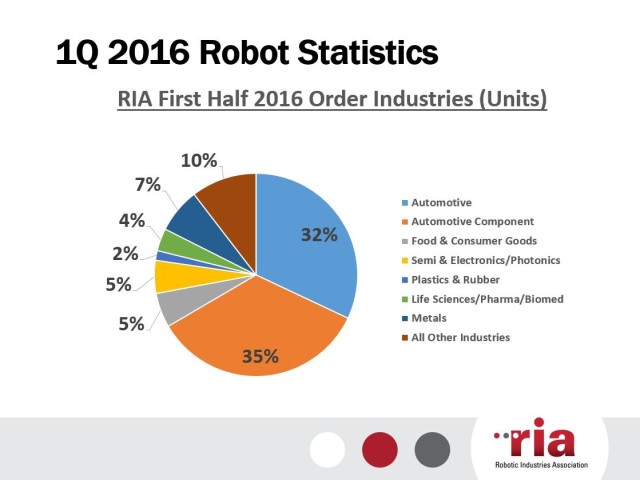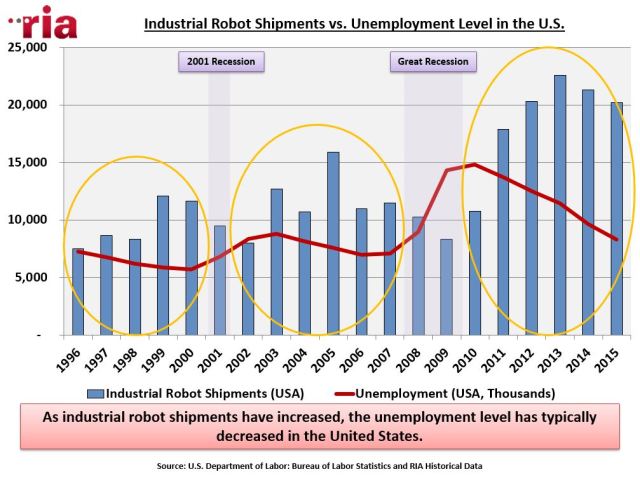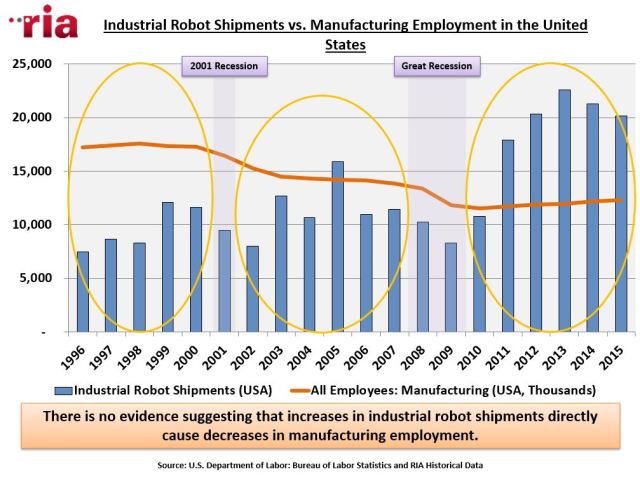Robot Orders Break Record in First Half of 2016
Sep 02, 2016

The North American automation industry broke records through the first half of 2016, according to statistics released by the Association for Advancing Automation (A3).
A record number of orders for industrial robots were booked early this year – 14,583 units, valued at approximately USD$817 million – from North American companies. This represents a growth of two percent over the same period in 2015.
Despite this growth, order revenues decreased by three percent in the first half of the year. However, shipment revenues hit a new record, as 13,620 robots valued at $838 million were shipped to North American customers.
Automotive Industry Drives Demand for Industrial Robots
Automotive OEMs were the number one driving factor of the increase in robot orders, placing 16 percent more orders for robots. Applications that saw the greatest influx of robotic automation included inspection (69 percent), assembly (38 percent) and spot welding (21 percent).
Component suppliers took second place in the contributor ranking, having increased their orders of industrial robots by four percent.
On the flip side, total orders from non-automotive industries collectively decreased by 14 percent.
This isn’t evidence, however, of a decrease of interest in non-automotive applications for industrial robots. The food and consumer goods industry saw a growth in orders of 41 percent over records of the same period in 2015.
“In my opinion, that decrease year over year in terms of first half performance is just the ebb and flow in the overall growth of non-automotive applications,” said Alex Shikany, director of market research at A3. “The overall quantities of robots ordered and installed in these industries has increased in every category.”

The Robotic Industries Association, which is part of A3, estimates that around 265,000 robots are now in use inside North American factories, behind only Japan and China.
Later in the year, A3 will be releasing statistics regarding how much of a role collaborative robots and autonomous mobile robots played in respect to overall industrial robot order growth.
“We don’t have the detailed system in place to extract what percentage of data are related to those two categories yet,” said Shikany. “However, in the third quarter of this year, we’re going to be rolling that out.”
Continued Growth, Employment and Automate 2017
Continued growth in demand for industrial robotics across North America is expected, as nations like China adopt robotic automation in force.
“China is one of the fastest growing robotics users the world has ever seen,” said Jeff Burnstein, president of A3. “I think more companies in the US are wondering how they’re going to compete when everyone else in the world is automating. More often than not, the answer is they’re going to automate too.”
For manufacturers and engineers still wary of what industrial robots means for them, the answer isn’t job loss, according to A3 experts.

“We see fearmongering technological unemployment articles on an almost daily basis,” said Bob Doyle, director of communications at A3.
The RIA is well known for sharing research findings on market and industry trends in relation to automation. The association has frequently reported a lack of direct cause and effect between automation with industrial robots and rising unemployment when referring to their own historical data and findings presented by the U.S. Department of Labor’s Bureau of Labor Statistics, among other sources.

“We’ll continue to fight the good fight and talk about why to compete internationally, it’s important to automate,” Doyle concluded.
As the upward trend in industrial robot demand increases, it seems many more manufacturers are turning optimistic. This optimism is also translating to larger turnouts at industry events such as the biannual Automate trade show.
“The exhibit floor at Automate 2017 is expected to be significantly larger than our 2015 event,” Burnstein said. “This growth is attributed to the fact that leading automation companies are reaching out to small and medium sized customers.
Source: ENGINEERING.com